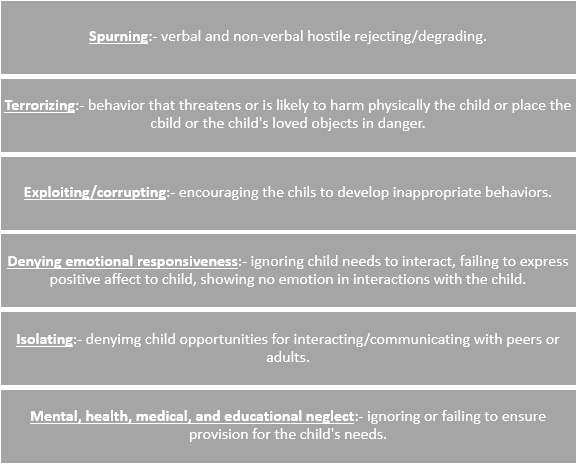
Author: Anas Al-Waqfi
Topic: Psychological Child Abuse & Maltreatment
Keywords: Child Maltreatment, Psychological Abuse, Emotional Abuse
Editor: Hala Qaryouti
Introduction
Child maltreatment is an intercontinental issue of serious life-long consequences with 3 out of 4 children aged between 2–4 years regularly suffering physical punishment and/or psychological violence at the hands of parents and caregivers[1]. According to the World Health Organization (WHO), the scope of child maltreatment and abuse targets those under the legal definition of a child, under 18 years.
The four forms of abuse identified include physical abuse, sexual abuse, psychological abuse, and neglect; with psychological abuse encompassing both emotional neglect and emotional abuse. However, not any form of emotional maltreatment or poor parenting is considered dysfunctional or abusive as there is a continuum that ranges from healthy to psychological maltreatment. Therefore, the risk of harm to the child is the primary distinguisher of dysfunctional parenting from psychological maltreatment. [2]
Unfortunately, until recently, psychological child abuse and maltreatment have not gained the required attention as a result of the difficulty in generalizing and applying findings. This is mainly due to lack of consistency in the definition and estimation of emotional maltreatment as well as the over-reliance on clinical, non-representative samples. [3,4]
Definitions
Psychological Abuse, also referred to as ‘Emotional Child Abuse’, has no single agreed-on definition till this moment, making it more challenging to identify or define than physical or sexual abuse.
In 1995, the American Professional Society of the Abuse of Children (APSAC) defined the term as “a repeated pattern of caregiver behavior or extreme incident(s) that convey to children that they are flawed, unloved, unwanted, endangered, or of value only in meeting another’s needs” [8]. The multiple patterns of psychological abuse suggested by the APSAC are classified into the types shown in figure (1) below [9].

Figure 1: Patterns of psychological abuse suggested by the APSAC.
The Diagnostic and Statistical Manual of Mental disorders (DSM-5) defines Psychological Child Abuse as “non-accidental verbal or non-verbal acts by a child’s parent or caregiver that result or may significantly result in noteworthy psychological harm to the child”. These acts include- but are not limited to- restriction of movement; patterns of depreciating, blaming, threatening, frightening, unfairness against or ridiculing. [5]
According to the American Academy of Pediatrics (AAP), behaviors of psychological child abuse acted by the caregiver include denying emotional responsiveness as well as medical, emotional, and educational neglect [6]. Emotional maltreatment can involve acts of both commission (i.e.: spurning and terrorizing described above) and omission (ignoring need for social interactions) which can negatively influence the child’s well-being [2]. However, the caregiver must be using 1 or more of such behaviors briefly or over a longer period to be classified as abuse [7].
Epidemiology
Unfortunately, compared to other forms of maltreatment, little is known about the prevalence and outcomes of psychological abuse, mainly due to its misinterpretation and underreporting in a relatively large percentage of cases [11].
According to a US study, the yearly prevalence of single types of maltreatment, child abuse is around 10% [12]. However, a meta-analysis of studies addressing psychological abuse found that a prevalence as high as 36% was calculated when based on self-reported cases, whereas only 0.3% when based on professional reports [13]. Both emotional neglect and emotional abuse were more prevalent among females compared to males (4% vs. 2%, respectively) [1].
According to Taillieu, Brownridge, Sareen, and Afifi, 2016, the most prevalent form of emotional maltreatment is emotional neglect alone (6.2%), followed by emotional abuse alone (4.8%), and both emotional abuse and neglect (3.1%) [14]. In addition, surveys carried out in the US found that psychological and emotional maltreatment were the most regularly self-reported forms of exploitation [16]. Furthermore, several large population-based self-report studies in the United Kingdom and United States found that around 8 – 9% of women and 4% of men reported being subjected to severe psychological abuse during childhood [15].
Etiology & Risk Factors
Attachment Theory states that a firm attachment bond with at least one primary caregiver is essential for emotional development. Emotional maltreatment is believed to interfere with the development of this attachment bond [22], and the subsequent insecure attachment patterns could explain the link between childhood emotional maltreatment and mental disorders [2].
Psychological child abuse is usually associated with multiple family stressors such as a larger family size, family conflicts (e.g.: custody disputes), death of a child in the family, lack of finances for essentials, accommodation problems, adult mental health problems, or parental substance abuse [17,18]. Other stressors include employment difficulties, marital separation, pediatric exposure to violence at home, and pregnancy [11]. In addition, any history of maternal depression during a child’s life has been linked to parental withdrawal and neglect [19,20].
Furthermore, children and adolescents with intellectual or cognitive disabilities may be more vulnerable to abuse [11]. Community violence, having a non-biological male caregiver, and inadequate understanding of child development are also considered important risk factors for child maltreatment [23]. In addition, a caregiver who has had low educational achievement or had been maltreated as a child can contribute to children maltreatment [24].
Allan N. Schore, author of “Affect Regulation and The Origin of The Self”, stated in his book that effects of psychological maltreatment during the first 3 years of life can be exaggerated, as rapid and extensive growth of the brain and biological systems takes place throughout this period, and it is largely affected by the child’s surrounding environment [21].
Long-term Consequences
Factors such as frequency, intensity, and duration of abuse, coping strategies practiced by the child, self-esteem, and availability of supportive relationships can alter the effects and sequelae on the psychologically abused child [25]. As per evidence available, severe emotional abuse can be as influential as physical abuse and contribute to depression and low self-esteem [3]. However, inability to control for the presence of other forms of parental aggression limit the understanding of its sequalae [26].
One study found that children emotionally abused under the age of 12 years have serious delinquency issues [10]. Childhood psychological abuse has been related to post-traumatic stress disorder, anxiety, depression, substance abuse, a decreased quality of life, as well as several axis-I and axis-II personality disorders [27–30] such as histrionic and borderline personality disorders [33], in addition to educational, socialization problems and disruptive behaviors [31,32].
Mater-University of Queensland Study of Pregnancy (MUSP) has revealed several outcomes of child maltreatment including cognitive and attention deficits, psychosis, PTSD, addiction problems, sexual issues, and physical limitations [3].
Therefore, acknowledging signs and symptoms of abuse and making appropriate referrals for assessment and treatment are vital skills of healthcare professionals by which further child maltreatment practices could be minimized [34].
Diagnosis
Psychological maltreatment remains a challenge to detect for healthcare professionals in general and pediatricians in particular. Pediatricians need to stay alert to consider psychological and emotional abuse in any assessment of psychological and behavioral conditions in children [34]. While pediatric providers may directly obtain signs or symptoms on emotional maltreatment by a parent or caregiver, getting history from the pediatric patient is the most beneficial tool for identification [2].
In early infancy, emotional abuse may manifest as decreased emotional expressiveness and interest in surroundings. Therefore, it is often mistaken for intellectual disability or physical illness. Consequently, children may be insecure, anxious, usually not trust-giving, superficial in social relationships, and overly concerned with pleasing adults [35].
Pediatricians should develop methods for asking children about their relationships with their caregivers, experiences of discipline and feelings of self-worth, security, and being loved [6]. The pediatrician also needs to be aware of risk indicators for psychological maltreatment mentioned above. It is equally important to be aware of the psychological maltreatment that can be associated with exposure to intimate partner violence. Also, children who abuse animals are more likely to be the subject of abuse themselves [36].
Child abuse can be investigated through multiple factors, as recommended by the Mayo Clinic, such as: physical examination to evaluate signs and symptoms of suspected abuse or neglect, lab tests and X-rays, obtaining the child’s medical and developmental history, description or monitoring the child’s behavior, paying attention to the interactions between parents or caregivers and the child, having informative talks with parents or caregivers, and if possible, talking with the pediatric patient. [47]
Guidelines such as Bright Futures [37] and The Addressing Mental Health Concerns in Primary Care toolkit [38] can both assist the pediatrician in children evaluation; however, they are not unique for psychological abuse. At last, physicians should acquire good understanding of the developmental roots of the adverse outcomes of emotional maltreatment and early-life trauma thus proper referrals of patients will be made to more appropriate treatment services [39].
Management & Prevention
As there is no complete understanding of psychological child abuse or the future life-long consequences [40]. nevertheless, the Center for Disease Control (CDC) recognizes the importance of emphasizing a safe, stable, and nurturing healthy relationships to prevent maltreatment [41].
Providers of pediatric healthcare have a unique opportunity to precisely evaluate the child’s emotional status and report reasonable suspicion to child welfare services. These are fundamentals of prevention and diagnosis therefore all healthcare workers in contact with children are considered reporters of child abuse and neglect [42] and every visit is an opportunity for investigation since psychological abuse has no apparent clinical signs. Early recognition and intervention through prenatal and early childhood home visitation by nurses carries long-term benefits such as decreased childhood internalizing problems [44], reduced antisocial behavior [46], and improved cognitive skills [44,46].
If a child reports being abused, their safety is most important. Normal and healthy psychological path of thinking should be re-instituted in the child’s mindset through several elements including encouraging the patient to tell what happened and express their feelings, reminding the child that the responsibility of being abused does not fall on him or her, reporting abuse to stakeholders, and helping provide safety. If the abuse has occurred in an institution such as school, these behaviors should be reported to the school principal and to ensure that such acts would not keep occurring. [47]
Different types of therapy have been suggested for the condition in perspective and those include (but are not limited to):
- Trauma Focused Cognitive Behavioral Therapy in which cognitive coping skills are provided and these include recognizing the relationship among thoughts, feelings, and behaviors related to everyday upsetting events and to traumatic experiences [50].
- Child-Parent Psychotherapy that is based on healing the effect of trauma in children through the parent-child relationship [51].
- Cognitive Behavioral Interventions for Trauma in Schools [52].
- Cognitive-based Cognitive behavioral therapy [53].
- Brief Psychoanalytic Psychotherapy [54].
Conclusion
Children experiencing psychological and emotional abuse usually suffer from low self-esteem, anxiety, distrustfulness, and depression. The long-term consequences of emotionally abusive behaviors may ultimately cause serious psychological health disorders that are much harder to treat or manage. As this condition commonly goes hidden and underestimated, it is therefore under-reported. Thus, strategies and certain processes should be set for the assessment of children who visit health care professionals and pediatricians for better and more comprehensive evaluation of their psychological health and well-being.
References...






